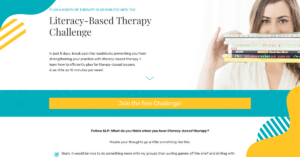When I was working as a school-based SLP, I consistently had a handful of “articulation only” students on my caseload. I always enjoyed working with these students, especially since it felt a little bit less overwhelming when it came to developing treatment plans. It was a lot more straightforward than language treatment, that’s for sure! I knew which articulation sounds I needed to target, thanks to the articulation norms my district provided me. I also had my “speech ladder” to guide my treatment. I was feeling good!
And then I came across this article… Brumbaugh and Smit (2013) conducted a survey and found that SLPs are not familiar with all evidence-based treatments for speech sound disorders.
I was fresh out of grad school. Didn’t I learn what I needed to learn about evidence-based strategies for speech sound disorders? I started to doubt myself… Was I doing what was best for my students? I thought my students were making “good” progress…
As I read more, I realized that I was one of those SLPs. I was missing a few pieces!
It took me a few years, but I decided to write this series of blog posts on articulation approaches for a few reasons:
1. Many of us are treating speech sound disorders! Based on ASHA’s 2014 Schools Survey, 92.7% of SLPs regularly serve students with articulation/phonological disorders.
2. Our caseload numbers keep growing, and it’s becoming more and more challenging to manage “all the things.” Refreshing our “toolbox” of approaches with students could help us “work smarter” and see more rapid progress with these students. (It’s not an immediate fix, but this could help us decrease our caseload size if we’re able to exit students more quickly!)
3. I’m still learning, but I’ve seen some amazing results from using a variety of evidence-based approaches with my students. I want to share those with you!
I’m collaborating with Lilly Manzi on this series! Lilly is an SLP working in a public elementary school near Richmond, VA. She can usually be found speed-walking around the school to work with all the awesome kids, reading up on new treatment ideas, or strolling outside to enjoy the sunshine.
You’ll hear from both of us as we review the approaches and share some case studies.
Before we dive in, let’s do a quick recap of the different types of speech sound disorders–just to make sure we’re on the same page!
Different Types of Speech Sound Disorders
Here’s a recap of different disorders that we may see:
Anatomic, Sensory, or Motoric Disorders
We may also see speech sound disorders related to structural/anatomic anomalies or motor execution/planning difficulties (e.g., dysarthria, apraxia of speech).
We will focus primarily on articulation and phonological disorders throughout this series, but we want to keep these in mind as we’re evaluating students and planning treatment!
We also have to recommend this free training by Dr. Edythe Strand for a great overview of Childhood Apraxia of Speech!
Articulation Disorders
Articulation disorders impact the production of specific sounds. Students will often produce substitutions or distortions.
Phonological Disorders
Students with phonological disorders make incorrect productions of sound classes (rather than just a few sounds). They may exhibit patterns in errors (e.g., final consonant deletion).
It can be difficult to differentiate articulation disorders from phonological disorders, which is why some clinicians/researchers refer to these disorders as “speech sound disorders” (Bernthal, Bankson, and Flipsen, 2017).
Need a recap? This visual by Dr. Caroline Bowen is super helpful in breaking down the different types of disorders.
A Quick Review of Approaches for Speech Sound Disorders
This list is not comprehensive, but it includes a sampling of the most commonly used approaches as well as approaches with stronger evidence.
We review each approach by breaking down the What, the When, the How, and the Who.
• What includes a quick description of the approach.
• When includes a quick description of how the treatment approach and/or targets are chosen.
• How includes a quick description of how treatment is planned/implemented.
• Who refers to which types of students we might benefit from the approach.
Traditional Articulation Therapy
• What: This is a developmental approach to target selection, where sounds are targeted based on order of acquisition.
• When: The child’s errors are not a part of a class of sound errors.
• How: Stimulable sounds are targeted first, in order of age of acquisition.
• Who: This is appropriate for children with a few errors scattered across sound classes.
Tambyraja, S. R., & Dunkle, J. T. (2014). Target Selection in Speech Therapy: Is a Non-Developmental Approach More Efficient Than a Developmental Approach? EBP Briefs, 8(5), 1-9.
Complexity Approach to Therapy
• What: This is a non-developmental approach to target selection, where sounds are targeted based on the level of complexity. Research shows that children acquire skills needed for less complex sounds while working on complex sounds, and that articulatory skills trickle down to foundational sounds.
• When: The child doesn’t yet produce the sound and is not stimulable.
• How: We target more complex, later-developing sounds first. The objective is to make fast changes.
• Who: This is appropriate for children with low speech intelligibility who are missing several sounds from their phonemic inventories.
Strokel, H. L. (2017). The Complexity Approach to Phonological Treatment: How to Select Treatment Targets. Language, Speech, and Hearing Services in Schools.
Cycles Approach to Articulation Therapy
• What: Phonological patterns are treated in cycles of 5 to 16 weeks. The error patterns are targeted in each cycle.
• When: The child presents with many sound omissions and some sound substitutions.
• How: A new cycle begins upon completion of a previous cycle.
• Who: This is appropriate for children with patterns of omissions and sound substitutions.
Hassink, J. M., & Wendt, O. (2010). Remediation of Phonological Disorders in Preschool Age Children: Evidence for the Cycles Approach. EBP Briefs, 5(2), 1-7.
For an overview of even more approaches, check out ASHA’s Practice Portal.
Want to hear more? We’ve got you!
Stay tuned for case studies to see how we implement these approaches with our caseload!




Reader Interactions